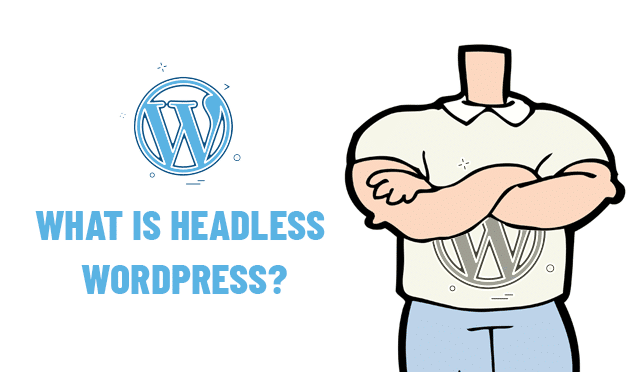
As WordPress continues to dominate the marketplace, it may seem to be the perfect content management system. After all, there are plenty of free and premium WordPress themes out there to make almost any project look great. But despite its many advantages its native structure does limit its utility.
Headless WordPress is a modified version of the CMS designed to remove these limits. But what exactly is headless WordPress and does your business actually need it?
What exactly is headless WordPress?

Headless WordPress is an example of a new breed of API-first content management systems. Traditionally, WordPress consists of a database, some code in a language called PHP and some more code for displaying the content to the user. These ‘back-end’ and ‘front-end’ modules are coupled together so that any changes in the back-end are reflected in the front (or head) end of the website.
This is all very well if you are only interested in displaying your content on one website but what if you want to adapt the content for use on a mobile app, a company intranet or a smart TV? You need some way of making the data available to external applications.
The magic of the REST API
Enter the WordPress REST API. The job of an application programming interface (API) is to communicate between different systems. This is a bit like a translator ensuring people who speak different languages can communicate together.
As long as an application is using the http protocol, the WordPress REST API can accept calls in many different languages enabling content to be adapted for different interfaces. Headless WordPress takes this a step further by decoupling the front-end entirely and placing the API at the center of the CMS.
Transforming user experience
Headless WordPress has the potential to transform user experience by enabling developers to create front-end applications specifically for different platforms. From mobile apps and social media pages to smart TVs, virtual reality headsets and connected devices, businesses can maintain brand identity while adapting the user interface to suit the device in question. In this way, businesses can create an omnichannel experience without redesigning applications for every different platform. This is particularly valuable for small businesses who may not have the budget to build native applications for multiple platforms. Due to the magic of the REST API, any update to the information in the WordPress database will be immediately reflected in the front-end applications.
Speeding up content delivery

Another thing that users will love your applications for is their speed. With 40% of users quitting a site if it hasn’t loaded within three seconds, there is a critical need for lightweight, fast-loading applications.
Since it won’t need to load the back-end every time, an application calling a headless WordPress site will be much quicker to load. REST APIs are also designed to intelligently make use of caching so that cached data will be used when appropriate.
By combining headless WordPress with a content delivery network (CDN), users around the globe will instantly have access to the same data as local users.
With a fast-loading website, social media page or application, your users will be happy and this will be reflected in engagement metrics. Since Google uses both user-focused metrics and page load speed in determining SEO ranking, you will see the benefit in your position on Google’s search pages too.
Progressive web apps (PWAs)
REST APIs are also the magic bullet that makes progressive web apps (PWAs) work. PWAs enable browser-based plug-ins and other lightweight front-end applications to behave much like a native web application. This means that developers can recreate much of the experience of your core website or application on the platforms they are working on. All without having to load the bulky core application.
A PWA is designed to:
- work for every user, regardless of device or browser choice
- work even in low quality networks
- refresh regularly to ensure content is up to date
- use https for added security
- be discovered by search engines like regular applications
- facilitate re-engagement through push notifications
- be storable on the users device
- be linkable via a share URL
Setting developers free

The best developers want to improve and perfect their craft. WordPress, despite its many advantages, does not let them do that. WordPress developers are in a niche (albeit a very big niche) where the main language they use is PHP. A great WordPress developer is an asset in today’s world but what happens if PHP becomes obsolete? You don’t want to be in the situation where your developer is out of touch with all other programming developments.
To future-proof your business you need to have the best developers for your budget and you need to keep them hungry. Headless WordPress uses JavaScript, the world’s most used programming language but the REST API can interact with multiple different languages, ensuring plenty of avenues for developers to explore and stay motivated.
Decluttering the back-end
One of the fantastic attributes of WordPress – and the key to much of its success – is the way it combines a content management system with a user-accessible development framework. From the same admin dashboard you can add a post, page or image, update to the latest version of WordPress, install a calendar plugin and design a mega menu.
The downside of this is clutter. Since the development aspect of a headless WordPress application is done ‘beneath the hood’. The back-end can be simplified for pure content management.
This will be great news for your content team who can speed up their workflow. Training new content creators on your system will also be much quicker as adding posts, pages and media becomes more intuitive.
Does your business need to lose its head?
Which brings us back to the burning question – the second part of the headline to this article. Does your business actually need headless WordPress? That depends on your vision for the future of your business, the competitiveness of your marketplace and the developers you have in your team (or are willing and able to hire).
If your vision doesn’t go beyond a single website, a standard WordPress installation will be sufficient. WordPress is built to be responsive so your site will still function well across browsers and devices. It will just load a little slower. This might still be a problem if you are competing against multiple faster sites. For example, e-commerce is a very competitive industry which is why Adobe are exploring headless CMS technology to speed up their Magento websites.
Do you speak JavaScript?
If you do have a progressive vision for your website (e.g. you want users to access your content from their car, through their VR headset or on their smart TV) then investing in headless WordPress now could be the smartest move you make.
Be warned though. It is definitely not the same as working with free WordPress themes and WordPress templates. Your development team will need to be experts in JavaScript in order to develop and maintain your site and will need to know how REST APIs work. The more coding languages they are fluent in the better as they can then work on applications in multiple development environments.
However, if you are only likely to be using one website and need the control to switch designs and add functions without coding knowledge, vanilla WordPress with its plethora of premium and free WordPress themes is probably still the way to go.
The post What is Headless WordPress? Does your Business Need it? appeared first on CSS Author.

As WordPress continues to dominate the marketplace, it may seem to be the perfect content management system. After all, there are plenty of free and premium WordPress themes out there to make almost any project look great. But despite its many advantages its native structure does limit its utility. Headless WordPress is a modified version […]
The post What is Headless WordPress? Does your Business Need it? appeared first on CSS Author.
[Collection]Wordpress
No comments: